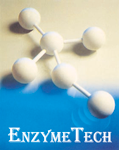- Home
- About Us
- Products
- Enzymology
- Enzyme Applications
- Contact Us
Enzymology
WHAT ARE ENZYMES?
Enzymes are proteins with highly specialized catalytic functions, produced by all living organisms. Enzymes that act as catalysts that significantly speed up the rate of virtually all of the chemical reactions that take place within cells. Enzymes are vital for life and serve a wide range of important functions in the body, such as aiding in digestion and metabolism.
Some enzymes help break large molecules into smaller pieces that are more easily absorbed by the body. Other enzymes help bind two molecules together to produce a new molecule. Enzymes are highly selective catalysts, meaning that each enzyme only speeds up a specific reaction. Enzymes are responsible for many essential biochemical reactions in microorganisms, plants, animals, and human beings. There are optimum temperatures and pH values at which their activity is greatest.
WHAT TYPES OF ENZYMES ARE THERE?
Enzymes are categorized according to the compounds they act upon. Some of the most common include; proteases which break down proteins, cellulases which break down cellulose, lipases which split fats (lipids) into glycerol and fatty acids, and amylases which break down starch into simple sugars.
HOW ARE ENZYME PREPARATIONS MADE?
Commercial sources of enzymes are obtained from three primary sources, i.e., animal tissue, plants and microbes. These naturally occurring enzymes are quite often not readily available in sufficient quantities for food applications or industrial use. However, by isolating microbial strains that produce the desired enzyme and optimizing the conditions for growth, commercial quantities can be obtained. This technique, well known for more than 3,000 years, is called fermentation. Today, this fermentation process is carried out in a contained vessel. Once fermentation is completed, the microorganisms are destroyed; the enzymes are isolated, and further processed for commercial use.
THE ADVANTAGES OF ENZYMES
The use of enzymes frequently results in many benefits that cannot be obtained with traditional chemical treatment. These often include higher product quality and lower manufacturing cost, and less waste and reduced energy consumption. More traditional chemical treatments are generally nonspecific, not always easily controlled, and may create harsh conditions. Often they produce undesirable side effects and/or waste disposal problems. The degree to which a desired technical effect is achieved by an enzyme can be controlled through various means, such as dose, temperature, and time. Because enzymes are catalysts, the amount added to accomplish a reaction is relatively small. For example, an enzyme preparation in most food uses is equal to 0.1% (or less) of the product. Enzymes used in food processing are generally destroyed during subsequent processing steps and not present in the final food product.
INDUSTRIAL ENZYMES AND THE ENVIRONMENT
Enzymes can often replace chemicals or processes that present safety or environmental issues. For example, enzymes can:
- Replace acids in the starch processing industry and alkalis or oxidizing agents in fabric desizing;
- Reduce the use of sulfide in tanneries;
- Replace pumice stones for “stonewashing” jeans;
- Allow for more complete digestion of animal feed leading to less animal waste; and
- Remove stains from fabrics. Clothes can be washed at lower temperatures, thus saving energy. Enzymes can be used instead of chlorine bleach for removing stains on cloth. The use of enzymes also allows the level of surfactants to be reduced and permits the cleaning of clothes in the absence of phosphates.
- Enzymes also contribute to safer working conditions through elimination of chemical treatments during production processes. For example, in starch, paper and textile processing, less hazardous chemicals are required when enzymes are used.
WHAT DOES THE FUTURE HOLD?
There are many enzymes existing in nature with significant potential value to society. However, these enzymes have not been commercially developed because they exist in organisms that cannot easily be used for production or where other components of the organism are unacceptable for the intended use. Isolating and then transferring the genes that code for these enzymes into an organism that can easily be grown and has been demonstrated to be a safe host can eliminate the unacceptable characteristics. The result will be valuable new enzymes, demonstrated to be safe, that are commercially available at affordable prices.
For example, with the modern tools of biotechnology, enzymes from nature can be accessed which are sufficiently robust to be useful at extremes of pH and temperature, and thus hold great promise for replacing certain chemical processes with much cleaner protein-catalyzed processes.
Overall, the use of modern biotechnology for enzyme production can have a major impact on improving the cost and quality of products we need and want while at the same time working towards sustainability. Enzymes will continue to play a very important role in facilitating more environmentally sound production and making production systems more sustainable.
